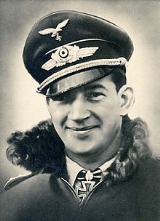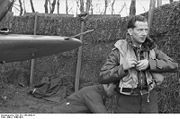
Hermann-Friedrich Joppien
Encyclopedia
Hauptmann
Hermann-Friedrich "Jupp" Joppien (19 July 1912 – 28 August 1941) was German
World War II
Luftwaffe
Flying ace
and recipient of the Knight's Cross of the Iron Cross with Oak Leaves . The Knight's Cross of the Iron Cross and its higher grade Oak Leaves was awarded to recognise extreme battlefield bravery or successful military leadership. It was Germany's highest military decoration at the time of its presentation to Hermann-Friedrich Joppien.
 Hermann-Friedrich Joppien was born on 19 July 1912 in Bochum
Hermann-Friedrich Joppien was born on 19 July 1912 in Bochum
. Joppien joined the military service with an Infantry Regiment in October 1931.
In mid 1939 Joppien was posted to 1 staffel, Jagdgeschwader 51
(JG 51). He claimed his first victory, a French Morane-Saulnier M.S.406
on 23 November 1939, although Joppien’s aircraft undercarriage had been damaged and his aircraft overturned on landing, Joppien escaping injury. Joppien claimed four victories during the 1940 French campaign. On 6 August 1940 Joppien became Staffelkapitän, 1./JG 51. Joppien then claimed 26 victories during the air battles over England. Joppien was awarded the Ritterkreuz and on 18 October 1940 appointed Gruppenkommandeur
, I./JG 51. He recorded his 40th claim on 21 April 1941. He was awarded the Oakleaves on 23 April for achieving 40 victories.
Joppien led I./JG 51 during the invasion of Russia and on 30 June 1941 shot down five Russian bombers near Bobruysk. 12 victories followed in July, including four Tupolev SB-2 bombers shot down on 2 July and another three SB-2s on 24 July.
However, after his 58th victory on 5 July, Joppien was wounded by bomber return fire and spent several weeks in hospital. On 28 August 1941 Joppien engaged in combat with Russian fighters and bombers near Yelnya
, southwest of Bryansk
. In the subsequent action Joppien was shot down and killed in his Bf 109 F-2
(W.Nr. 9670) "Black <<" by a Russian MiG-3 fighter.
"Jupp" Joppien was officially credited with 70 victories. His victory total included 42 aerial victories claimed over the Western front
among them 23 Supermarine Spitfires.
Hauptmann
Hauptmann is a German word usually translated as captain when it is used as an officer's rank in the German, Austrian and Swiss armies. While "haupt" in contemporary German means "main", it also has the dated meaning of "head", i.e...
Hermann-Friedrich "Jupp" Joppien (19 July 1912 – 28 August 1941) was German
Germany
Germany , officially the Federal Republic of Germany , is a federal parliamentary republic in Europe. The country consists of 16 states while the capital and largest city is Berlin. Germany covers an area of 357,021 km2 and has a largely temperate seasonal climate...
World War II
World War II
World War II, or the Second World War , was a global conflict lasting from 1939 to 1945, involving most of the world's nations—including all of the great powers—eventually forming two opposing military alliances: the Allies and the Axis...
Luftwaffe
Luftwaffe
Luftwaffe is a generic German term for an air force. It is also the official name for two of the four historic German air forces, the Wehrmacht air arm founded in 1935 and disbanded in 1946; and the current Bundeswehr air arm founded in 1956....
Flying ace
Flying ace
A flying ace or fighter ace is a military aviator credited with shooting down several enemy aircraft during aerial combat. The actual number of aerial victories required to officially qualify as an "ace" has varied, but is usually considered to be five or more...
and recipient of the Knight's Cross of the Iron Cross with Oak Leaves . The Knight's Cross of the Iron Cross and its higher grade Oak Leaves was awarded to recognise extreme battlefield bravery or successful military leadership. It was Germany's highest military decoration at the time of its presentation to Hermann-Friedrich Joppien.
Military career

Bochum
Bochum is a city in North Rhine-Westphalia, western Germany. It is located in the Ruhr area and is surrounded by the cities of Essen, Gelsenkirchen, Herne, Castrop-Rauxel, Dortmund, Witten and Hattingen.-History:...
. Joppien joined the military service with an Infantry Regiment in October 1931.
In mid 1939 Joppien was posted to 1 staffel, Jagdgeschwader 51
Jagdgeschwader 51
Jagdgeschwader 51 Mölders was a Luftwaffe fighter wing during World War II, named after the fighter ace Werner Mölders in 1942. JG 51's pilots won more Ritterkreuz des Eisernen Kreuzes than any other Jagdgeschwader, and flew combat from 1939 in all major theatres of war. Flying Bf 109s and then...
(JG 51). He claimed his first victory, a French Morane-Saulnier M.S.406
Morane-Saulnier M.S.406
The M.S.406 was a French Armée de l'Air fighter aircraft built by Morane-Saulnier starting in 1938. Numerically it was France's most important fighter during the opening stages of World War II....
on 23 November 1939, although Joppien’s aircraft undercarriage had been damaged and his aircraft overturned on landing, Joppien escaping injury. Joppien claimed four victories during the 1940 French campaign. On 6 August 1940 Joppien became Staffelkapitän, 1./JG 51. Joppien then claimed 26 victories during the air battles over England. Joppien was awarded the Ritterkreuz and on 18 October 1940 appointed Gruppenkommandeur
Gruppenkommandeur
Gruppenkommandeur is a Luftwaffe position , that is the equivalent of a commander of a group or wing in other air forces. Gruppenkommandeur usually has the rank of Hauptmann or Major, and commands a Gruppe, which is a sub-division of a Geschwader. A Gruppe usually consists of three or four...
, I./JG 51. He recorded his 40th claim on 21 April 1941. He was awarded the Oakleaves on 23 April for achieving 40 victories.
Joppien led I./JG 51 during the invasion of Russia and on 30 June 1941 shot down five Russian bombers near Bobruysk. 12 victories followed in July, including four Tupolev SB-2 bombers shot down on 2 July and another three SB-2s on 24 July.
However, after his 58th victory on 5 July, Joppien was wounded by bomber return fire and spent several weeks in hospital. On 28 August 1941 Joppien engaged in combat with Russian fighters and bombers near Yelnya
Yelnya
Yelnya is a town and the administrative center of Yelninsky District of Smolensk Oblast, Russia, situated on the Desna River from Smolensk. Population: -History:...
, southwest of Bryansk
Bryansk
Bryansk is a city and the administrative center of Bryansk Oblast, Russia, located southwest of Moscow. Population: -History:The first written mention of Bryansk was in 1146, in the Hypatian Codex, as Debryansk...
. In the subsequent action Joppien was shot down and killed in his Bf 109 F-2
Messerschmitt Bf 109
The Messerschmitt Bf 109, often called Me 109, was a German World War II fighter aircraft designed by Willy Messerschmitt and Robert Lusser during the early to mid 1930s...
(W.Nr. 9670) "Black <<" by a Russian MiG-3 fighter.
"Jupp" Joppien was officially credited with 70 victories. His victory total included 42 aerial victories claimed over the Western front
Western Front (World War II)
The Western Front of the European Theatre of World War II encompassed, Denmark, Norway, Luxembourg, Belgium, the Netherlands, France, and West Germany. The Western Front was marked by two phases of large-scale ground combat operations...
among them 23 Supermarine Spitfires.
Awards
- Iron CrossIron CrossThe Iron Cross is a cross symbol typically in black with a white or silver outline that originated after 1219 when the Kingdom of Jerusalem granted the Teutonic Order the right to combine the Teutonic Black Cross placed above a silver Cross of Jerusalem....
2nd and 1st class - Knight's Cross of the Iron Cross with Oak LeavesKnight's Cross of the Iron CrossThe Knight's Cross of the Iron Cross was a grade of the 1939 version of the 1813 created Iron Cross . The Knight's Cross of the Iron Cross was the highest award of Germany to recognize extreme battlefield bravery or successful military leadership during World War II...
- Knight's Cross on 16 September 1940 as OberleutnantOberleutnantOberleutnant is a junior officer rank in the militaries of Germany, Switzerland and Austria. In the German Army, it dates from the early 19th century. Translated as "Senior Lieutenant", the rank is typically bestowed upon commissioned officers after five to six years of active duty...
and StaffelkapitänStaffelkapitänStaffelkapitän is a position in flying units of the German Luftwaffe that is the equivalent of RAF/USAF Squadron Commander. Usually today a Staffelkapitän is of Oberstleutnant or Major rank....
of the 1./JG 51 - 11th Oak Leaves on 23 April 1941 as HauptmannHauptmannHauptmann is a German word usually translated as captain when it is used as an officer's rank in the German, Austrian and Swiss armies. While "haupt" in contemporary German means "main", it also has the dated meaning of "head", i.e...
and GruppenkommandeurGruppenkommandeurGruppenkommandeur is a Luftwaffe position , that is the equivalent of a commander of a group or wing in other air forces. Gruppenkommandeur usually has the rank of Hauptmann or Major, and commands a Gruppe, which is a sub-division of a Geschwader. A Gruppe usually consists of three or four...
of I./JG 51
- Knight's Cross on 16 September 1940 as Oberleutnant
- Mentioned three times in the WehrmachtberichtWehrmachtberichtThe Wehrmachtbericht was a daily radio report on the Großdeutscher Rundfunk of Nazi Germany, published by the Oberkommando der Wehrmacht regarding the military situation on all fronts of World War II....

